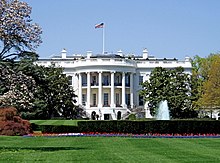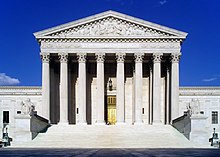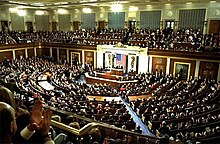United States politics
The government of the United States is based on an anatomy, presidential and federal. Your government has limited powers enumerated in the United States Constitution. Their form of government is known as a presidential democracy because there is a president. The election of the president is indirect through delegates or big voters.
The powers of the president reach not only the head of state, but also the executive power and the capacity of some decisions of the legislative power. There are levels of government: the federal level, the state level, and the county or local level. The leaders of these territorial administrations are elected by voters by universal suffrage or appointed by other elected officials. Almost all trades are decided by a plurality of votes for one candidate. The candidates win the elections, not the political parties, whose influence and organization is less than in other democratic systems such as those in Europe. All Americans have the right to vote at the age of 18. There are limits on the right to vote for those who are in prison for committing crimes that carry the restriction of voting as an accessory penalty; In some states, criminal and penitentiary legislation restricts the right to vote even after serving the sentence, and the residents of the dependencies and the federal district are represented only with a non-voting delegate to Congress. To exercise the right to vote, you must register in a voter registry.
The country is made up of 50 autonomous states in its internal regime. The main political parties are the Republican Party and the Democratic Party, which dominate the political scene for what some consider the system of this country as a two-party democracy. Other minor parties include the Green Party, the Constitution Party, and the Libertarian Party. However, they practically do not have representation because the Democratic and Republican parties have more than 95% of the territorial representation.
The Constitution of the United States, of September 17, 1787 with its 7 articles and its 27 subsequent amendments, defines that the United States is a Republic with a representative and federal system with three defined, separate powers that are balanced between them and administered in its executive branch by a president elected for a period of 4 years with a possible re-election for a single more term.
The president has the powers of head of state and government, in addition to being the commander-in-chief of the Army. He is also the head of the executive branch that is invested in him and that he exercises by himself and with the vice president and members of the Cabinet, the heads of the executive departments, which are 15: State, Treasury, Defense, Justice, National Security, Interior, Agriculture, Commerce, Labor, Health and Social Services, Education, Housing and Urban Development, Transportation, Energy and Veterans Affairs.
Electoral Suffrage
Americans go to the polls on the first Tuesday of November every four years (coinciding with years that are multiples of four) to elect a new President of the United States. The party that wins the popular election has the right to send the voters of its party to the electoral college that will elect the President. The number of delegates varies according to the state population.
How does it work?
There are 538 electoral votes divided among the 50 states and the District of Columbia. Each state has one elector for each of its members in Congress: one for each legislator in the House of Representatives (determined by state population) and one for each senator (each state has two). A candidate needs half plus one of the electoral votes, that is 270, to reach the presidency.
Most states award all of their electoral votes to the candidate who has won the popular vote in the state. The electors then cast two votes each: one for president and one for vice president. These votes are sent to Congress where they are certified.
What happens if there is a tie?;How is it solved?
If two presidential candidates receive the same number of electoral votes, the House of Representatives will decide who becomes president and the Senate will decide who becomes vice president. This, if none of the state votes are challenged. In the 2000 elections several state ballots were challenged.
How many times has a president won the electoral vote (and the presidency) without winning the popular vote?
Four times, most recently in 2016, when Republican Party nominee Donald Trump became the 45th President of the United States, when he was elected by 304 electoral votes to the Democratic Party nominee's 227 votes and former first lady of the United States, Hillary Clinton, despite the fact that the latter won the popular vote (remember that a minimum of 270 electoral votes is needed to be elected). Clinton won 65,853,516 popular votes (48.18%) and Trump 62,984,825 (46.09%), but Trump's victory in 30 states led him to get enough votes in the Electoral College to be elected president.
The last time was in 2000, when a close Florida state election forced a recount and Supreme Court intervention that ruled in favor of Republican Party candidate George W. Bush. Bush won 271 electoral votes, despite the fact that the Democratic Party candidate and former vice president in the Clinton administration, Al Gore won the popular vote.
Bush won 50,455,156 votes, equivalent to 47%, and Gore 50,992,335, or 48%. The other opportunities were the elections of 1876 and 1888.
The work of the delegates consists of validating the presidential popular election. The President of the United States is elected in an assembly made up of 538 voters. This number is equal to the sum of:
538 = 100 Senators + 435 Representatives + 3 Delegates from Washington D.C. which has no Senators but Delegates.
In these ballots, each candidate for president has attached the name of his Vice President and the party to which he belongs. In each state, the candidate with the most votes wins. But these votes do not elect the President for the moment, but rather the bloc elect the delegates of this political option who will later go to the electoral college. Since there are 538 electors in all, a candidate needs at least 270 to be elected. Which translates to 269 (half of 538) + 1 = 270 seats to be named President of the United States.
Some of the functions of the president
The president has the power to appoint members of the Cabinet, which will be approved by the Senate, as well as nominate Supreme Court judgeships, which must be approved by the Senate. He also has the power to veto laws that have been passed in Congress.
Legislative branch
On the other hand, there is the legislative power, which is vested in the United States Congress, which is made up of the Senate and the House of Representatives.
The House of Representatives
The House of Representatives is made up of members elected every two years. This election also works by the majority system and in each constituency the candidate who obtains the most votes will be the only one elected. The number of Representatives that each state has is based on the number of inhabitants it has.
The House of Representatives elects its Speaker, who would serve as President of the United States in the event that the President and Vice President of the United States were incapacitated. The House also elects its other officers and has the power to file constitutional charges against any of the Union's civil officers.
The Senate
The United States Senate is made up of two Senators from each State, which currently yields a total of one hundred Senators. The President of the United States needs the advice and consent of the Senate, by a two-thirds majority of the Senators present, in order to conclude international agreements and treaties and to appoint the persons he proposes to positions such as executive departments, embassies, and Consulates and Courts of Justice. Senators are elected for a six-year term, renewing one third of the Chamber every two years.
To be a senator of the United States of America, a series of requirements must be met: being over 30 years of age, residing in the state they represent, and being a citizen of the United States for at least 9 years prior to their election as senator.
The President of the Senate is the Vice President of the United States. In case of absence or dismissal, the Senate elects a president pro tempore. Usually the Vice President does not preside over the Senate, so the President Pro Tempore of the Senate becomes the de facto President of the United States Senate.
Political parties
The major political parties are the Republican Party and the Democratic Party.
Third parties with little representation and limited to a particular territory are the Constitution Party, the Libertarian Party and the Green Party.
There are many other minor parties, such as the Reform Party, Peace and Freedom Party, Socialist Workers Party, Personal Choice Party, Write-Ins Party, Socialist Party, Prohibition Party and the Centrist Party.
Debate on the topicality of the election system
Due to the particularity of the electoral system in the United States, there are divergent opinions about the representativeness of the system, the relevance and relevance of its application.
Both houses must pass a bill for it to become law, but the president can veto it or refuse to sign it. In that case, Congress reconsiders the bill. If two thirds of the members of both chambers approve it, the bill becomes a Law on Rights) guarantees individual freedoms: religion, assembly, expression, the right to a fair trial, respect for the housing of each. Subsequent amendments chronicle America's fight for equal justice for all its people. These amendments have abolished slavery, prohibit any denial of rights based on race, give women and citizens of the District of Columbia the vote, and allow citizens to vote at age 18.
Contenido relacionado
XIX century
Tacit
History of america




